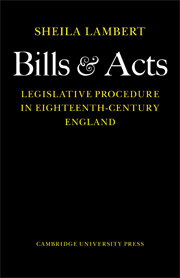Book contents
- Frontmatter
- Contents
- Preface
- Abbreviations
- Introduction
- 1 Robert Harper and parliamentary agency
- 2 Treatises and handbooks
- 3 The clerks: fees and agency
- 4 Parliamentary business
- 5 Private bill procedure
- 6 Estate bills
- 7 Inclosure bills
- 8 Local bills
- 9 Promulgation of the statutes
- 10 Conclusion
- Appendix I List of bills drawn by Robert Harper
- Appendix II Note on parliamentary sources
- Index
9 - Promulgation of the statutes
Published online by Cambridge University Press: 07 October 2011
- Frontmatter
- Contents
- Preface
- Abbreviations
- Introduction
- 1 Robert Harper and parliamentary agency
- 2 Treatises and handbooks
- 3 The clerks: fees and agency
- 4 Parliamentary business
- 5 Private bill procedure
- 6 Estate bills
- 7 Inclosure bills
- 8 Local bills
- 9 Promulgation of the statutes
- 10 Conclusion
- Appendix I List of bills drawn by Robert Harper
- Appendix II Note on parliamentary sources
- Index
Summary
The King's Printer's patent gave him the right to print all acts of parliament, but he had discretion as to the exercise of his prerogative and, since the Treasury was his largest customer, he came under Treasury supervision. A clerk at the House of Lords prepared bills for the Royal Assent, dividing them into the categories of public and private. Public acts received the assent in the form ‘le roi le veult’ and private in the form ‘soit fait comme il est desiré’. At the House of Lords, the original acts, ingrossed on parchment rolls, were numbered and preserved in the order in which they had received the assent, sometimes on several separate occasions during a session, public and private being therefore mixed up together. The division into public and private as we know it today was made by the King's Printer when he came to make up his sessional set of acts. He arranged the public and the private acts in two separately numbered series, printing the texts of the former, but only a list of the titles of the latter.
He printed the text of all the truly public general acts, such as the supply and mutiny acts and all matters of state; these acts were of their own nature public and did not contain a clause declaring them to be so. But from at least the late seventeenth century, it became usual to insert such a clause into privately promoted bills, especially the local acts for roads, rivers, town improvements and so on.
- Type
- Chapter
- Information
- Bills and ActsLegislative procedure in Eighteenth-Century England, pp. 172 - 186Publisher: Cambridge University PressPrint publication year: 1971



